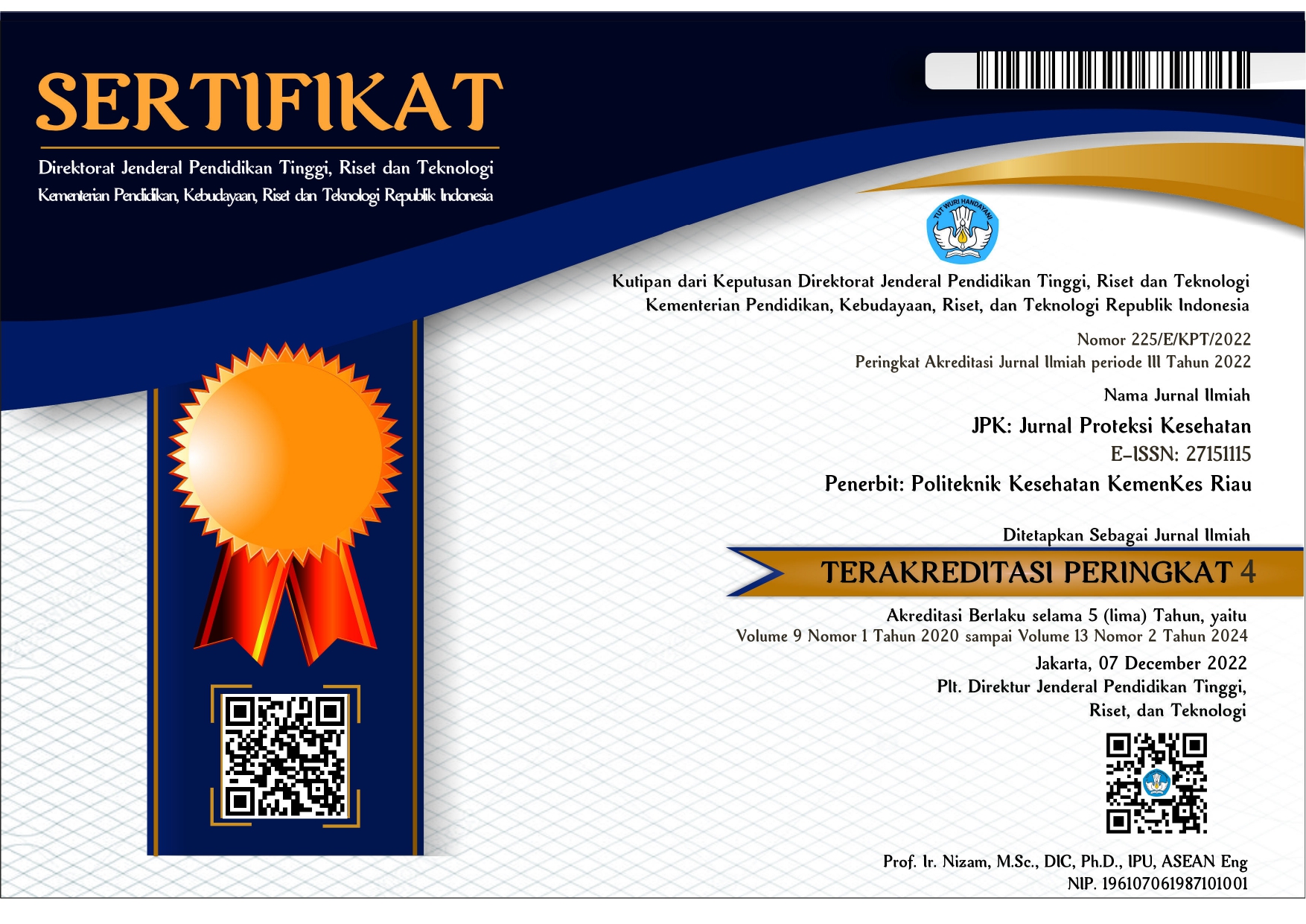Validity Test Of The Foot And Ankle Outcomes Questionnaire as a Measurement Tool For Flat Foot
Abstract
The Foot and Ankle Outcomes Questionnaire (FAOQ) assesses disability in the foot and ankle across five areas: pain, symptoms, daily activities, sports and leisure, and quality of life. This study, conducted in 2020, aimed to validate the FAOQ for measuring flat foot in 12-year-old children. Nineteen children with flat feet from Al Abidin Islamic Middle School in Banyuanyar, Surakarta, participated, selected through purposive sampling and Clark's Angle footprint analysis. Each participant provided written consent. The study utilized the FAOQ and Clark's Angle footprint analysis to test the validity of the Indonesian FAOQ version using the Pearson Product Moment. Out of 25 questions, 16 were found invalid and 9 valid. With a table value of 0.482 and a margin of error of 0.05, the FAOQ is deemed valid if the table value exceeds the calculated value. Thus, the Indonesian FAOQ version is invalid for assessing flat foot in 12-year-old children.
References
[2] M. Pfeiffer, R. Kotz, T. Ledl, G. Hauser, and M. Sluga, “Prevalence of flat foot in preschool-aged children,” Pediatrics, 2006, vol. 118, no. 2, pp. 634–639, doi: 10.1542/peds.2005-2126.
[3] M. A. Villarroya, J. M. Esquivel, C. Tomás, L. A. Moreno, A. Buenafé, and G. Bueno, “Assessment of the medial longitudinal arch in children and adolescents with obesity: Footprints and radiographic study,” Eur. J. Pediatr., 2010, vol. 168, no. 5, pp. 559–567, doi: 10.1007/s00431-008-0789-8.
[4] K. C. Chen, C. J. Yeh, J. F. Kuo, C. L. Hsieh, S. F. Yang, and C. H. Wang, “Footprint analysis of flatfoot in school-aged children,” Eur. J. Pediatr., 2011, vol. 170, no. 5, pp. 611–617, doi: 10.1007/s00431-010-1330-4.
[5] G. Gijon-Nogueron, A. Marchena-Rodriguez, J. Montes-Alguacil, and A. M. Evans, “Evaluation of the paediatric foot using footprints and foot posture index: A cross-sectional study,” J. Paediatr. Child Health, 2019, pp. 1–6, doi: 10.1111/jpc.14558.
[6] S. Pita-Fernández et al., “Variability between Clarke’s angle and Chippaux-Smirak index for the diagnosis of flat feet Variabilidad entre el ángulo de Clarke y el índice de Chippaux-Smirak para el diagnóstico de pie plano Colombia Médica,” Colomb. Med., 2017, vol. 48, no. 1, pp. 25–31, [Online]. Available: http://www.cambre.org/.
[7] A. Martínez-Nova, G. Gijón-Noguerón, P. Alfageme-García, J. Montes-Alguacil, and A. M. Evans, “Foot posture development in children aged 5 to11 years: A three-year prospective study,” Gait Posture, 2018, vol. 62, no. October 2017, pp. 280–284, doi: 10.1016/j.gaitpost.2018.03.032.
[8] B. K. G. de Carvalho, P. J. Penha, N. L. J. Penha, R. M. Andrade, A. P. Ribeiro, and S. M. A. João, “The influence of gender and body mass index on the FPI-6 evaluated foot posture of 10- to 14-year-old school children in São Paulo, Brazil: A cross-sectional study,” J. Foot Ankle Res., 2017, vol. 10, no. 1, pp. 1–7, doi: 10.1186/s13047-016-0183-0.
[9] J. L. Riskowski, T. J. Hagedorn, and M. T. Hannan, “Measures of foot function, foot health, and foot pain: American Academy of Orthopedic Surgeons Lower Limb Outcomes Assessment: Foot and Ankle Module (AAOS-FAM), Bristol Foot Score (BFS), Revised Foot Function Index (FFI-R), Foot Health Status Questionnaire (FHSQ), Manchester Foot Pain and Disability Index (MFPDI), Podiatric Health Questionnaire (PHQ), and Rowan Foot Pain Assessment (ROFPAQ),” Arthritis Care Res., 2011, vol. 63, no. SUPPL. 11, doi: 10.1002/acr.20554.
[10] A. Kothari, P. C. Dixon, J. Stebbins, A. B. Zavatsky, and T. Theologis, “The relationship between quality of life and foot function in children with flexible flatfeet,” Gait Posture, 2015, vol. 41, no. 3, pp. 786–790, doi: 10.1016/j.gaitpost.2015.02.012.
[11] Y. Analay Akbaba, D. Celik, and R. T. Ogut, “Translation, Cross-Cultural Adaptation, Reliability, and Validity of Turkish Version of the American Orthopaedic Foot and Ankle Society Ankle-Hindfoot Scale,” J. Foot Ankle Surg., 2016, vol. 55, no. 6, pp. 1139–1142, doi: 10.1053/j.jfas.2016.06.001.
[12] S. Mohamadi, I. Ebrahimi, M. Dadgoo, M. Salavati, A. Saeedi, and B. Valiollahi, “Translation, cross-cultural adaptation and factor analysis of the Persian version of ankle instability instrument,” Med. J. Islam. Repub. Iran, 2018, vol. 32, no. 1, pp. 459–463, doi: 10.14196/MJIRI.32.79.
[13] H. Retnawati, “Validitas dan reliabilitas konstruk skor tes kemampuan calon mahasiswa,” J. Ilmu Pendidik., 2017, vol. 23, no. 2, pp. 126–135.
[14] J. B. Kim, J. K. Kim, S. G. Seo, and D. Y. Lee, “Validity, Reliability, and Responsiveness of the Korean Version of American Academy of Orthopedic Surgeons Foot and Ankle Questionnaire,” J. Foot Ankle Surg., 2015, vol. 54, no. 1, pp. 46–50, doi: 10.1053/j.jfas.2014.08.011.
[15] B. A. Zelle, B. S. Francisco, J. P. Bossmann, R. J. Fajardo, and M. Bhandari, “Spanish Translation, Cross-Cultural Adaptation, and Validation of the American Academy of Orthopaedic Surgeons Foot and Ankle Outcomes Questionnaire in Mexican-Americans with Traumatic Foot and Ankle Injuries,” J. Orthop. Trauma, 2017, vol. 31, no. 5, pp. e158–e162, doi: 10.1097/BOT.0000000000000789.
[16] A. Chu, S. Chaudhry, D. A. Sala, D. Atar, and W. B. Lehman, “Calcaneocuboid arthrodesis for recurrent clubfeet: What is the outcome at 17-year follow-up?,” J. Child. Orthop., 2014, vol. 8, no. 1, pp. 43–48, doi: 10.1007/s11832-014-0557-4.
[17] C. Morris, H. A. Doll, A. Wainwright, T. Theologis, and R. Fitzpatrick, “The Oxford ankle foot questionnaire for children: Scaling, reliability and validity,” J. Bone Jt. Surg. - Ser. B, 2008, vol. 90, no. 11, pp. 1451–1456, doi: 10.1302/0301-620X.90B11.21000.
[18] P. Fahy and W. K. Hoy, “the end of construct validity,” Inf. Age, 2010, no. January, pp. 209–228.
[19] M. E. Strauss and G. T. Smith, “Construct Validity: Advances in Theory and Methodology,” Annu. Rev. Clin. Psychol., 2019, vol. 5, no. 1, pp. 1–25, doi: 10.1146/annurev.clinpsy.032408.153639.
[20] N. J. Madeley, K. J. Wing, C. Topliss, M. J. Penner, M. A. Glazebrook, and A. S. E. Younger, “Responsiveness and validity of the SF-36, Ankle osteoarthritis scale, AOFAS ankle hindfoot score, and foot function index in end stage ankle arthritis,” Foot Ankle Int., 2012, vol. 33, no. 1, pp. 57–63, doi: 10.3113/FAI.2012.0057.












